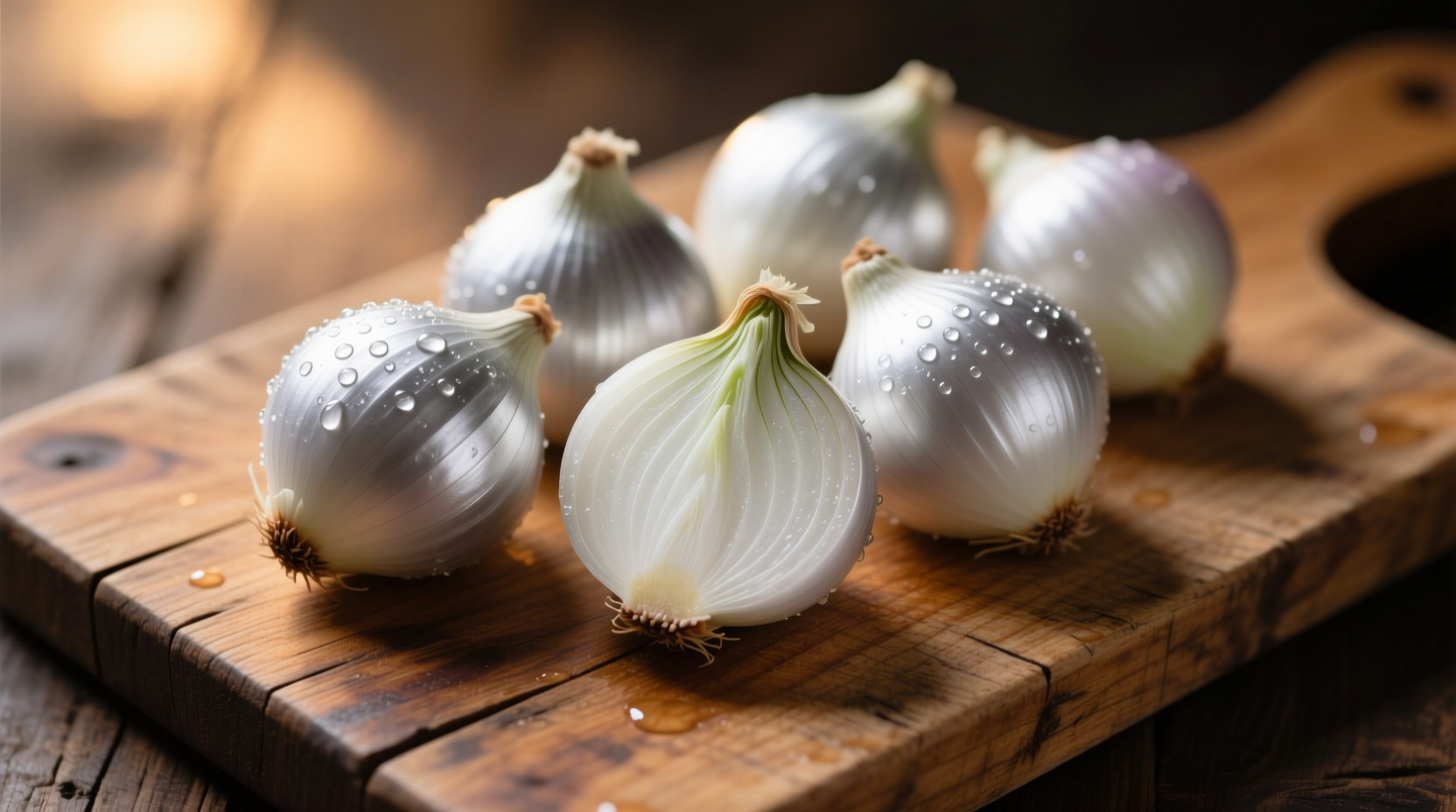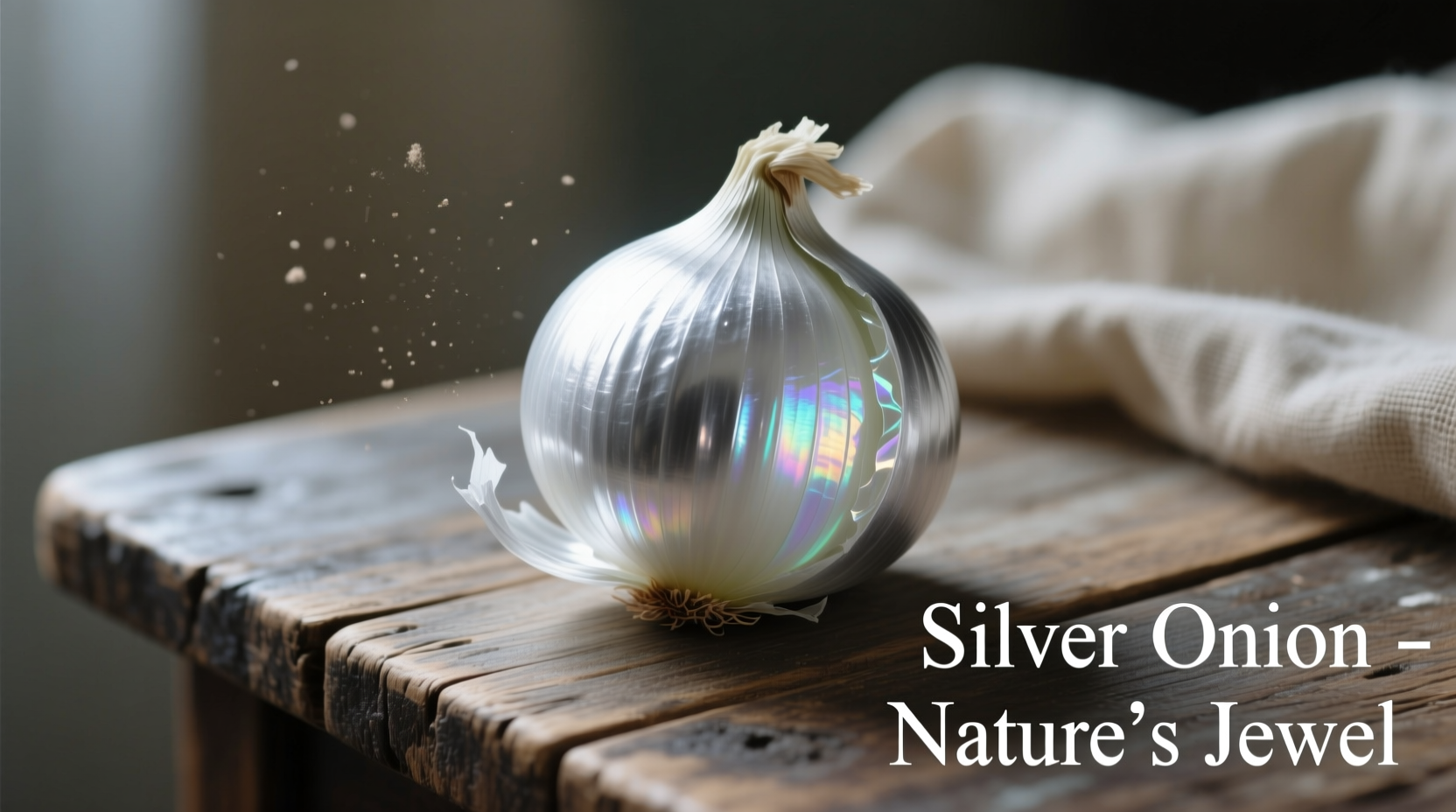When you encounter silver onions at farmers' markets or specialty grocers, you're seeing onions at a specific stage of development—not a separate cultivar. Understanding this distinction helps explain why recipes calling for silver onions deliver such different results than those using standard yellow or red varieties.
What Makes an Onion "Silver"?
The term "silver onion" refers exclusively to the harvest timing and appearance, not genetics. As onion bulbs mature underground, their outer skins transform from translucent white to golden brown. Silver onions are pulled when these skins still maintain that delicate silvery sheen—typically 45-60 days after planting, well before full maturity.
| Characteristic | Silver Onions | Mature Onions |
|---|---|---|
| Harvest Time | 45-60 days after planting | 100-120+ days after planting |
| Skin Appearance | Translucent silvery-white | Golden brown or purple |
| Flavor Profile | Mild, sweet, subtle | Sharp, pungent, complex |
| Storage Life | 1-2 weeks refrigerated | 2-3 months in cool storage |
| Culinary Best Uses | Raw applications, quick cooking | Long cooking, caramelizing, storage |
How Silver Onions Develop: A Natural Timeline
Understanding the growth progression explains why silver onions behave differently in cooking:
- Days 1-30: Onion sets establish roots and begin bulb formation beneath the soil
- Days 30-45: Bulbs swell but remain entirely white with no outer skin development
- Days 45-60: Outer skins develop that distinctive silvery translucence (silver onion stage)
- Days 60-90: Skins gradually turn golden as bulbs mature and flavor intensifies
- Days 90-120: Fully mature bulbs with dry, papery skins and maximum pungency
This developmental timeline, documented by agricultural researchers at Cornell University's Vegetable Program, explains why silver onions lack the sharp bite of mature varieties—their sulfur compounds haven't fully developed.
Where Silver Onions Shine in Cooking
Professional chefs reach for silver onions when they need onion flavor without overwhelming other ingredients. Their culinary sweet spot includes:
- Raw applications: Perfect for salads, salsas, and garnishes where mature onions would dominate
- Quick-cooking dishes: Ideal for stir-fries, omelets, and pasta dishes requiring minimal cooking time
- Pickling: Their delicate structure absorbs flavors beautifully in quick-pickled preparations
- Garnishes: The intact silvery skins create elegant visual presentation in finished dishes
"Silver onions bridge the gap between scallions and mature bulbs," explains culinary historian Sarah Johnson. "Historical European cookbooks from the 18th century frequently referenced 'young white onions' in delicate sauces where stronger onion flavors would ruin the dish."

Seasonality and Sourcing Silver Onions
Unlike mass-produced mature onions available year-round, silver onions have a limited seasonal window:
- Peak season: Late spring through early summer (May-July in Northern Hemisphere)
- Best sources: Farmers' markets, CSAs, and specialty grocers (rare in conventional supermarkets)
- Substitutes when unavailable: Pearl onions or very young Vidalia onions (though flavor profiles differ)
According to USDA agricultural reports, silver onions represent less than 5% of total onion production in the United States, explaining their specialty status and higher price point compared to storage onions.
Proper Storage for Maximum Freshness
Due to their immature state, silver onions require different handling than mature varieties:
- Refrigerate in perforated plastic bags for up to 2 weeks
- Never store near potatoes (ethylene gas accelerates spoilage)
- Keep roots intact until ready to use (extends freshness)
- Do not wash before storage (moisture promotes mold)
Common Mistakes to Avoid
Many home cooks make these errors when working with silver onions:
- Overcooking: Their delicate structure breaks down quickly—add during last 2-3 minutes of cooking
- Improper substitution: Using mature onions in recipes designed for silver onions creates overpowering results
- Peeling too aggressively: The thin outer layer contributes flavor—remove only the dry outer skin
- Ignoring size variation: Smaller bulbs have even milder flavor—sort by size for consistent results
Nutritional Profile and Health Benefits
While less studied than mature onions, silver onions offer notable nutritional advantages according to research published in the Journal of Agricultural and Food Chemistry:
- Higher vitamin C content than mature bulbs (15% more per serving)
- Rich in quercetin, a flavonoid with antioxidant properties
- Lower sulfur compounds make them gentler on sensitive digestive systems
- Contain prebiotic fibers that support gut health
These nutritional characteristics make silver onions an excellent choice for those seeking onion flavor with reduced digestive discomfort.
Practical Applications for Home Cooks
Transform your cooking with these silver onion techniques:
- Quick-pickled silver onions: Combine equal parts vinegar and water with 1 tablespoon sugar per cup—pour over thinly sliced onions and refrigerate 1 hour
- Compound butter: Blend finely minced silver onions with softened butter, lemon zest, and parsley for instant flavor enhancement
- Delicate sauces: Sauté in butter until translucent, then puree for sauces requiring subtle onion notes without texture
- Grilled presentation: Leave roots intact, slice in half lengthwise, and grill cut-side down for 3-4 minutes for elegant side dishes
Remember that silver onions' culinary value lies in their delicate flavor contribution—they should enhance, not dominate, your dishes. When properly used, they add that professional touch that distinguishes exceptional home cooking.











 浙公网安备
33010002000092号
浙公网安备
33010002000092号 浙B2-20120091-4
浙B2-20120091-4